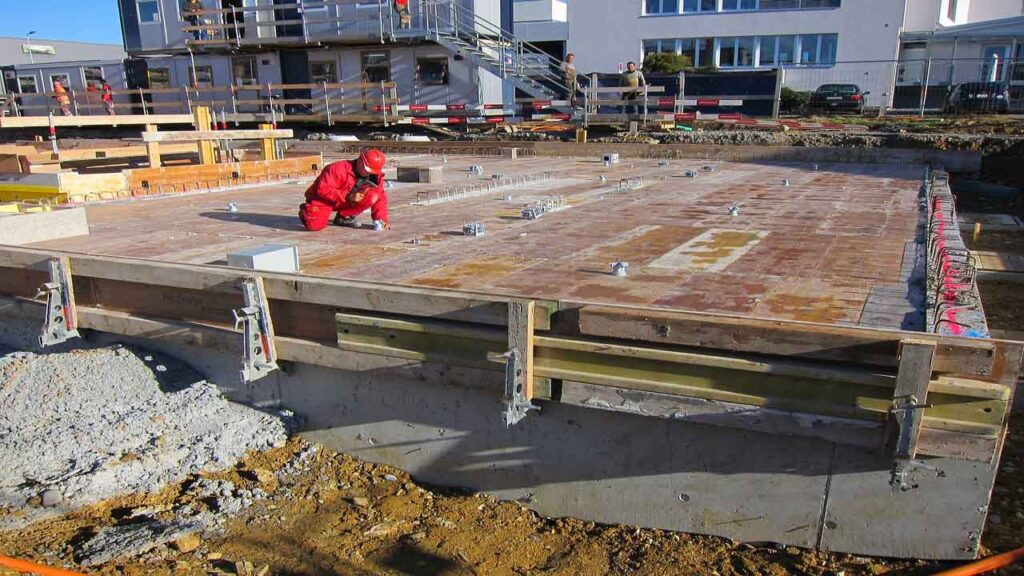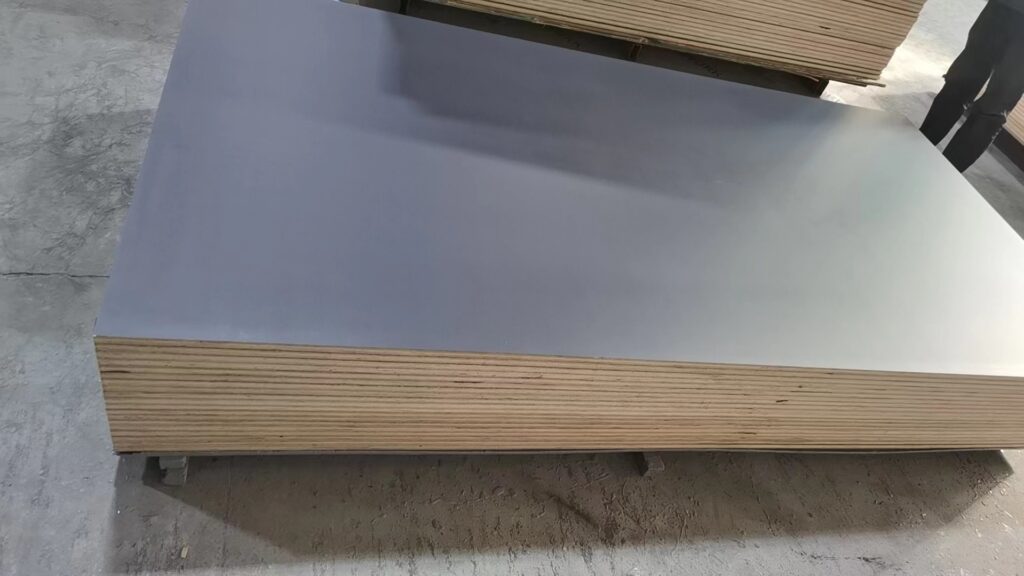Construction formwork is an integral part of any building project, providing temporary support during the construction process. One material that has gained popularity in recent years for formwork applications is F14 grade plywood. This article will delve into the basics of F14 grade plywood, its role in construction formwork, comparing it with other materials, its environmental impact, and tips for purchasing and using it effectively.
Understanding the Basics of F14 Grade Plywood
The first step to understanding the benefits of F14 grade plywood is to familiarize ourselves with its composition and manufacturing process. F14 grade plywood is made from thin layers of wood veneer that are glued together with high-quality adhesives under pressure. This construction method results in a strong and durable product that can withstand the rigors of construction formwork.
Composition and Manufacturing Process
F14 grade plywood is typically made from hardwood or softwood veneers. Hardwood veneers are known for their strength and durability, while softwood veneers provide flexibility and cost-effectiveness. These veneers are stacked together with each layer’s grain direction perpendicular to the previous layer. This cross-grain orientation enhances the plywood’s strength and prevents warping.
Once the veneers are stacked, they are bonded together using water-resistant adhesives and subjected to high pressure and heat. This manufacturing process ensures that the plywood is solid, stable, and capable of withstanding heavy loads and exposure to moisture.

Key Features of F14 Grade Plywood
F14 grade plywood possesses several key features that make it ideal for construction formwork. Firstly, it has a high structural rating, meaning it can support significant loads without deforming or breaking. This makes it suitable for various formwork applications, including walls, slabs, and columns.
Secondly, F14 grade plywood has excellent dimensional stability. This means that it retains its shape and size even under changing climatic conditions, reducing the risk of formwork failure due to swelling or shrinking. Its stability also ensures accurate and consistent concrete pours, resulting in a high-quality finish.
Furthermore, F14 grade plywood has a smooth finish, which allows concrete to adhere to it effectively. This prevents concrete leakage or honeycombing, ensuring a structurally sound and aesthetically pleasing final product.
But let’s delve deeper into the manufacturing process of F14 grade plywood. After the veneers are bonded together, the plywood undergoes a rigorous quality control process. Each sheet is carefully inspected for any defects or imperfections that could compromise its structural integrity.
Once the plywood passes the quality control check, it is then cut into standard sizes and packaged for distribution. The packaging is designed to protect the plywood from any potential damage during transportation and storage, ensuring that it arrives at the construction site in perfect condition.
It’s worth noting that F14 grade plywood is also environmentally friendly. The wood used in its production comes from sustainably managed forests, ensuring the long-term viability of the timber industry. Additionally, the adhesives used in the manufacturing process are low in volatile organic compounds (VOCs), minimizing the impact on indoor air quality.
In conclusion, F14 grade plywood is a versatile and reliable material for construction formwork. Its composition, manufacturing process, and key features make it a preferred choice for builders and contractors. Whether you’re constructing walls, slabs, or columns, F14 grade plywood provides the strength, stability, and durability required for successful formwork applications.
The Role of F14 Grade Plywood in Construction Formwork
Now that we understand the basics of F14 grade plywood, let’s explore why it is a preferred choice for construction formwork.
Why Choose F14 Grade Plywood for Formwork?
F14 grade plywood offers several advantages over other materials when it comes to formwork. Firstly, its high strength-to-weight ratio allows for easy handling and transportation on construction sites. This saves time and labor during the formwork setup and dismantling processes.
Secondly, F14 grade plywood is highly durable. It can withstand repeated use and exposure to moisture without deteriorating, ensuring that it can be reused multiple times. This longevity makes it a cost-effective solution for construction projects, reducing the need for frequent material replacements. Read more about deteriorating at https://www.ncbi.nlm.nih.gov/pmc/articles/PMC10308707/
The Durability and Strength of F14 Plywood in Construction
One of the primary concerns in construction formwork is the ability to support the weight of wet concrete. F14 grade plywood excels in this area, as it possesses exceptional load-bearing capacity. This makes it suitable for even the most demanding formwork applications, such as high-rise buildings or heavy industrial structures.
F14 grade plywood is also resistant to impact and deformation, further enhancing its durability. It can withstand the pressures exerted during the concrete pouring process without buckling or deforming, ensuring a stable and secure formwork system.
Additionally, F14 grade plywood undergoes rigorous testing and quality control measures to ensure its performance and reliability. It is manufactured using high-quality veneers that are bonded together with strong adhesives, creating a solid and stable panel. This construction process results in a plywood sheet that is not only strong but also resistant to warping, twisting, and delamination.
Furthermore, F14 grade plywood is designed to withstand harsh environmental conditions. It is treated with preservatives and coatings that protect it from fungal decay, termites, and other pests. This makes it suitable for both indoor and outdoor formwork applications, providing long-lasting performance and peace of mind to construction professionals.
Lastly, F14 grade plywood offers versatility in design and customization. It can be easily cut, shaped, and drilled to meet specific formwork requirements. This flexibility allows for the creation of complex and intricate formwork structures, enabling architects and engineers to bring their creative visions to life.
Comparing F14 Grade Plywood with Other Materials
When it comes to construction formwork, making an informed decision is crucial. While F14 grade plywood offers numerous advantages, it is important to compare it with other commonly used materials to understand its true value.
F14 Plywood vs. Traditional Wood
Traditional wood has been a popular choice for formwork in construction projects. However, it is not without its drawbacks. One of the main issues with traditional wood is its susceptibility to warping, splitting, and swelling when exposed to moisture. These factors can compromise the integrity of the formwork, leading to costly repairs and delays. In contrast, F14 grade plywood boasts superior moisture resistance and dimensional stability, ensuring that the formwork remains intact throughout the construction process. This means less time and money spent on maintenance and repairs, allowing the project to progress smoothly.
Strength and consistency are also areas where F14 grade plywood outshines traditional wood. While traditional wood may have natural variations in strength and quality, plywood is manufactured to meet specific grade standards, guaranteeing its structural performance. This consistency in strength not only enhances the safety of the construction site but also provides peace of mind to builders and contractors.
F14 Plywood vs. Other Plywood Grades
Within the realm of plywood, there are various grades available. However, F14 grade plywood stands out due to its higher strength and durability. While lower-grade plywood may be suitable for non-structural applications, F14 grade plywood offers the necessary load-bearing capacity and stability required for construction formwork. This makes it an ideal choice for projects where structural integrity is of utmost importance.
Furthermore, F14 grade plywood’s smooth and consistent surface is a crucial factor in achieving high-quality finishes in architectural projects. The surface ensures proper concrete adhesion, eliminating the risk of leakage or surface imperfections. This not only enhances the aesthetic appeal of the final structure but also contributes to its longevity and durability. to find more about leakage click here.
When comparing F14 grade plywood with other materials, it becomes evident that its superior moisture resistance, dimensional stability, strength, and consistency make it a standout choice for construction formwork. Its ability to withstand the rigors of the construction process and deliver high-quality finishes sets it apart from traditional wood and lower-grade plywood. By choosing F14 grade plywood, builders and contractors can ensure the success and longevity of their construction projects.

The Environmental Impact of Using F14 Grade Plywood
As sustainability plays a crucial role in modern construction practices, it is essential to assess the environmental impact of using F14 grade plywood.
Sustainability of F14 Grade Plywood
F14 grade plywood is considered a sustainable building material. It is made from renewable wood resources, which can be responsibly sourced from well-managed forests. Additionally, plywood production typically generates less waste compared to other construction materials, further reducing its environmental footprint.
Many manufacturers also prioritize using low-emission adhesives during the plywood manufacturing process. This reduces the release of volatile organic compounds (VOCs), which are harmful to both human health and the environment.
Recycling and Disposal of F14 Plywood
At the end of its lifespan, F14 grade plywood can be recycled or repurposed, minimizing waste and environmental impact. Recycling options may include shredding and reusing the wood fibers, or using the plywood in other applications such as furniture or packaging materials.
If recycling is not feasible, F14 grade plywood can be disposed of in an eco-friendly manner. Many regions have specific guidelines for the proper disposal of plywood, including designated waste management facilities or collection points.
Purchasing and Using F14 Grade Plywood
When it comes to purchasing and using F14 grade plywood, there are a few considerations to keep in mind to ensure optimal results.
Tips for Buying High-Quality F14 Plywood
When purchasing F14 grade plywood, it is essential to source it from reputable suppliers. Look for manufacturers that adhere to stringent quality control standards and have a track record of producing reliable plywood products. Additionally, ensure that the plywood meets relevant industry standards and certifications.
Inspect the plywood sheets for any visible defects, such as knots, cracks, or delamination. It is also advisable to check the thickness and dimensions of the plywood to ensure it meets your specific project requirements.
Best Practices for Using F14 Plywood in Construction Formwork
To maximize the performance of F14 grade plywood in construction formwork, it is crucial to follow best practices during its installation and use.
Ensure that the plywood is adequately supported and braced to prevent sagging or buckling under the weight of wet concrete. Proper reinforcement and support systems should be employed, especially in areas of higher stress or load concentration.
Regular maintenance and inspection of the plywood formwork are also essential to identify any signs of damage or wear. Promptly address any issues and replace damaged plywood sheets to maintain the structural integrity of the formwork.
Additionally, ensure that the plywood is stored in a dry and ventilated area to prevent moisture absorption, which could lead to swelling or warping.
Conclusion
F14 grade plywood is undoubtedly a reliable choice for construction formwork. Its high strength, dimensional stability, and durability make it ideal for various formwork applications. When compared to traditional wood and other plywood grades, F14 grade plywood stands out in terms of structural performance and consistency.
Furthermore, F14 grade plywood’s environmental impact is relatively low, thanks to its renewable sourcing and recycling potential. By following tips for purchasing and using high-quality F14 grade plywood, construction professionals can ensure efficient and sustainable formwork solutions.
Learn about formply at: Tips for Selecting the Best Formply for Your Building Needs

